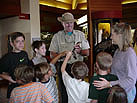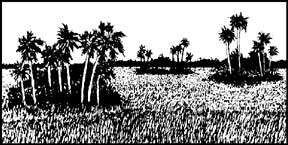
 |
Newsletter of the Merritt Island Wildlife Association |
Monday, October 7, 2002(In case of NASA closure ceremony will occur the following Monday, October 14, 2002)9:00 amJoin us in dedicating the Sendler Education Outpost. Program to include remarks by Congressman Dave Weldon, Roy Bridges (KSC Director), Margo McKnight (Brevard Zoo Executive Director), Ron Hight (Refuge Manager), and Forrest McCartney (MIWA President). Brevard County students will participate and refreshments will be provided. Everyone is encouraged to attend.
Please RSVP to Sandee Larsen at 321-861-2377
Directions: from US 1 or I-95 in Titusville
|
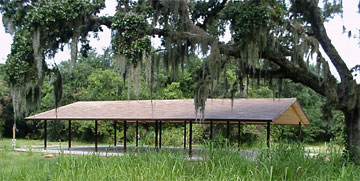 The Merritt Island National Wildlife Refuge wants to thank MIWA for taking on the significant financial challenge of funding the Sendler Education Outpost. Last year, when the Refuge presented MIWA with the challenge of funding an educational facility, MIWA did not hesitate. In just a few months, MIWA’s Board used its connections in the community to raise over $50,000, more than enough to fund the pavilion. Educating young people about environmental issues is a priority for the Refuge. MIWA and this facility will make it possible to launch a new education venture that will affect the lives of 6,000 children in its first year. Congratulations to MIWA for its support, vision and commitment to making a difference in our community.
The Merritt Island National Wildlife Refuge wants to thank MIWA for taking on the significant financial challenge of funding the Sendler Education Outpost. Last year, when the Refuge presented MIWA with the challenge of funding an educational facility, MIWA did not hesitate. In just a few months, MIWA’s Board used its connections in the community to raise over $50,000, more than enough to fund the pavilion. Educating young people about environmental issues is a priority for the Refuge. MIWA and this facility will make it possible to launch a new education venture that will affect the lives of 6,000 children in its first year. Congratulations to MIWA for its support, vision and commitment to making a difference in our community.
A dedication of the Sendler Education Outpost is planned October 7 at 9:00 am. You will find an invitation to this event on the back cover. Please mark this date on your calenda and take the time to celebrate with us. Your support made this possible. Allow the Refuge and the community the opportunity to thank you for this great new facility and educational cause.
Dorn Whitmore
The rains this summer have turned the Refuge into a very lush and green area. It is good to see all of the water and the green vegetation. The road at Black Point has been completed and opened. It is a beautiful drive, so plan to come by and enjoy it.
Our Association now has almost 500 members. It is the largest and most active ever. Thanks for your continued support and help in making the Merritt Island National Wildlife Refuge the very best. We are very fortunate to have such a resource and be able to enjoy it. Come often and enjoy.
See you at the dedication of the Outpost on October 7.
Forrest McCartney
 |  | |
| President Vice President Treasurer Secretary President Emeritus |
Forrest McCartney Charlie Roberts Warren Camp Dan LeBlanc George English | |
| Board Members Sam Beddingfield, Wes Dean, Judy Dryja, Bud Ferguson, Darleen Hunt, John Hutchison, Fred Mastin, George Meguiar, Jim Pedersen, Diane Stees & Laurilee Thompson | ||
| Refuge Manager: Ron Hight USFWS Liaison:Dorn Whitmore — NASA Liaison: Mike Sumner | ||
| The Merritt Island Wildlife Association (MIWA) is a nonprofit, cooperating association for the Merritt Island National Wildlife Refuge. Habi-Chat is published quarterly. For membership, MIWA or Refuge information, call 321-861-0667. | ||
| Interim Newsletter Editor Beth Homa — Technical Consultant Sandee Larsen | ||
You have also read about the development of a Comprehensive Conservation Plan that will provide Refuge guidance over the next 15 years. We expect several issues to come up that could have long-term impacts on the Refuge. For example, should the Refuge allow horseback riding? Should the impoundments be managed more for fisheries than for migratory birds? These and many other issues will be discussed. We encourage you to get involved in the process and help us guide the future management of the Refuge.
The Refuge is making a commitment to controlling exotic plants. This is a huge undertaking. If you have visited recently, you may have seen some of the evidence in the dead Australian pines.
They look unsightly now, but in time these areas will be replaced with natives that will enhance, not diminish wildlife habitat. The next big project is Brazilian pepper eradication. This will take years, but we think the payoff is worth it.
Finally I want to invite you to help celebrate the Centennial Anniversary of the National Wildlife Refuge System at Pelican Island NWR next March. This will be a gala event, complete with pageantry and maybe even a Presidential visit. 2003 will be declared "The Year of the National Wildlife Refuges," and it will be MINWR’s 40th anniversary. Come celebrate at Pelican Island and help us by offering suggestions on how we can commemorate your Refuge.
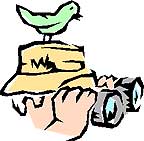 Newly arrived to the east coast of Florida last summer, I was inching my way along Bio Lab Drive, riveted on the scattered few birds that presented themselves to me in the marsh that time of year. I wasn’t expecting anything grand, but the egrets and herons were fascinating me anyway. I glanced up to the sky to curse at the humidity and mosquitoes, and instead spotted a large flock of white birds soaring high on the thermals. As I watched in awe, the sun glinted off the brilliant white of the flock soaring so high they disappeared if they angled just so. They were too far away to snap any pictures, so I just sat on the hood of my car and marveled at how nature can take your breath away when you least expect it. Being from Indiana and unfamiliar with white pelicans, I was awestruck as I watched them circle and meander their way north.
Newly arrived to the east coast of Florida last summer, I was inching my way along Bio Lab Drive, riveted on the scattered few birds that presented themselves to me in the marsh that time of year. I wasn’t expecting anything grand, but the egrets and herons were fascinating me anyway. I glanced up to the sky to curse at the humidity and mosquitoes, and instead spotted a large flock of white birds soaring high on the thermals. As I watched in awe, the sun glinted off the brilliant white of the flock soaring so high they disappeared if they angled just so. They were too far away to snap any pictures, so I just sat on the hood of my car and marveled at how nature can take your breath away when you least expect it. Being from Indiana and unfamiliar with white pelicans, I was awestruck as I watched them circle and meander their way north. White pelicans, I learned as I stole a glance at my Peterson Field Guide, are similar to brown pelicans, but are much larger - with wingspans up to 9 _ feet. White pelicans have black primary feathers, giving them a similar appearance to the smaller wood stork, and adults have an orange-yellow bill, while immature bills are gray. White pelicans inhabit a variety of habitats, depending on the time of year. During breeding season, they nest on isolated islands in lakes and feed in shallow waters such as lakes, streams, rivers and marshes. While migrating, they frequent lakes and rivers for stops. They winter along the coast, in shallow bays and in estuaries. White pelicans eat mostly fish, but unlike brown pelicans that dive for their prey, white pelicans scoop up fish as they swim. During breeding season, males have a bump on the top of their bills, but its exact function is unknown.
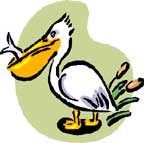 White pelicans can be year-round residents in Florida, but most populations are migratory. It is estimated there may be as many as 300-400 white pelicans on the Refuge in winter, with some flocks reaching sizes of 200 individuals. White pelicans tend to be colonial - they migrate in large flocks and nest in colonies. In addition, the nest is built by both the male and female and both parents feed the young.
White pelicans can be year-round residents in Florida, but most populations are migratory. It is estimated there may be as many as 300-400 white pelicans on the Refuge in winter, with some flocks reaching sizes of 200 individuals. White pelicans tend to be colonial - they migrate in large flocks and nest in colonies. In addition, the nest is built by both the male and female and both parents feed the young.
Colonies of white pelicans are vulnerable to habitat loss and disturbance. With increased human populations along America’s coastlines, the white pelican is rapidly losing its important wetland and beach habitat. This is particularly true in Florida, where humans and nature often clash. The Refuge is currently developing a 15-year plan that will help us address this conflict. Our hope is that as a MIWA member, you will attend our public meetings this fall and winter to give us input and support Refuge management decisions regarding white pelicans and other resources.
Sandy Edmondson
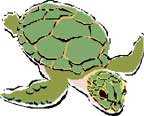 On Saturday, June 22, after a stormy afternoon, the skies cleared just in time for the MIWA members- only turtle watch. Approximately thirty people attended the program held at the Merritt Island NWR and Canaveral National Seashore. Dorn Whitmore, Refuge Liaison, conducted an informative and entertaining program about sea turtles and the nesting process in the Refuge Visitor Center while Wayne Lindsey and Beth Homa searched the shoreline for nesting activity. After battling swarming carpenter ants and a minor power outage, the group was rewarded with the opportunity to witness one loggerhead crawling up the beach and another actively nesting. Thank you to all who attended and made yet another successful MIWA event possible.
On Saturday, June 22, after a stormy afternoon, the skies cleared just in time for the MIWA members- only turtle watch. Approximately thirty people attended the program held at the Merritt Island NWR and Canaveral National Seashore. Dorn Whitmore, Refuge Liaison, conducted an informative and entertaining program about sea turtles and the nesting process in the Refuge Visitor Center while Wayne Lindsey and Beth Homa searched the shoreline for nesting activity. After battling swarming carpenter ants and a minor power outage, the group was rewarded with the opportunity to witness one loggerhead crawling up the beach and another actively nesting. Thank you to all who attended and made yet another successful MIWA event possible.
MIWA 9th Annual Meeting |
| Agenda topics include annual financial report, Board Member elections, programming ideas and Refuge update. Refreshments will be served and door prizes given away. Members are encouraged to attend. This is a great way to meet fellow members and become involved in your association. Please contact George English, Nomination Committee Chair, for nominations or other information 321.783.1108 |

MIWA is proud to announce volunteers, Joanne Napeiralski, Karl Eichhorn, Walt Kanjorski, Liz Kanjorski, Bob Anderson, Dolores Neumann, Mary Ann Theis and George Schoen have been awarded MIWA’s Certificate of Achievement. This is an annual award given to volunteers who have reached 100 hours of service. Each volunteer will receive a complimentary one-year individual membership and a certificate signed by MIWA President Forrest McCartney. Thank you to all our volunteers for their dedication and support.
MIWA would like to welcome our newest Life Members Marian Lunsford of Port Orange, FL and Lewis Oliver of Titusville, FL. Marian and Lewis will receive benefits including discounts on field trips, educational programs and purchases at the MIWA gift shop.
For MIWA membership information please call 321-861-2377 or visit our website at www.nbbd.com/npr/miwa/.
Sandee Larsen


 Thayer Birding Software’s "Our Birds: Florida" is now available.
Thayer Birding Software’s "Our Birds: Florida" is now available.The software includes videos, fun quizzes, photos, personal bird lists, and maps of the 299 birds regularly found in Florida. Retail price is $24.95.
New item for children and adults, plush Audubon birds with authentic Cornell Laboratory of Ornithology calls. Retails for $6.95.
Also now available: the National Wildlife Refuge "Celebrating a Century of Conservation" poster by Carl Freeman, which retails for $6.95 and commemorates the Centennial celebration of the Refuge system.
Don’t forget to show your MIWA membership card to receive your 10% discount on all purchases.
Visitor Information Center HoursMonday through Friday8:00 a.m. – 4:30 p.m.
Saturday and Sunday* *VIC is closed Sundays from April-October The Refuge is open daily from Sunrise to Sunset, except during Shuttle launch operations. Please call 321.861.0667 for more information. |
This forum ultimately helps the biologists and managers at the Seashore and Refuge to better understand this complex system, preserving and protecting the outstanding natural resources for future generations to enjoy. The Conference is held every other year, with participation by more than 20 federal, state and local agencies and educational institutions.
The Workshop began as a one-day event and has now expanded to a 2-day conference with 41 papers being presented in 2002. About 80 participants attended each day. The wide variety of topics included historical landscape changes, weather patterns, tides, sea turtles, sea grasses, oysters, fish, horseshoe crabs, migratory waterfowl, shorebirds, wading birds, dolphins, lizards, drift algae, water quality, groundwater, sea level rise, upland habitats, exotic species and wetland restoration.
Although the main focus has been on estuarine and wetland subjects, the Conference seeks an ecosystem approach to include studies of abiotic factors (e.g., weather, nutrients and water quality) and non-biological issues of public use or other socio-economic investigations that would link directly to natural resource management important to our study area. Paper presentations and abstract submissions for aquatic and terrestrial systems (upland habitats and species) are appropriate.
For the 2002 Biennial Mosquito Lagoon Conference, special acknowledgment and appreciation is extended to Ms. Laurilee Thompson of the Dixie Crossroads Restaurant for sponsoring the facilities at Emma Parrish Theater. Additional appreciation goes to all the individuals who volunteered their time to attend and present information to us and the individuals who assisted in organizing this year’s event. We are already looking forward to the 2004 Mosquito Lagoon Conference!
Abstracts from this conference can be read in PDF format by clicking here.
Marc Epstein
Volunteers NeededHelp! MINWR is in need of volunteers to provide information at the Visitor Center desk and as Refuge Rovers, lead bird tours and other programs, conduct waterbird surveys, aid in CCP efforts and assist in trail maintenance and litter pickup. If anyone is interested please contact
Sandy Edmondson at |
